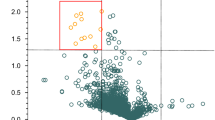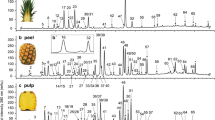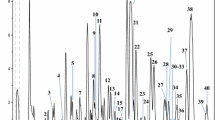Abstract
Tequila is elaborated from Agave tequilana Weber blue variety and it is commercialized at different stages of aging. Chemical composition of this product has often been addressed; however, data on phenolic compounds are scarce. In this work, a high-performance liquid chromatography–electrospray ionization-ion trap mass spectrometry (HPLC–ESI-ITMS) procedure has been established for the determination of 34 small phenolic compounds. The combination of suitable separation conditions with extraction of chromatograms at individual m/z values has enabled for total analysis run of 17 min (11 min separation plus 6 min column cleaning/equilibration) with the detection limits in the range 1.28–75.0 μg l−1 (0.07–6.1 pmol on-column). Commercial tequilas analyzed included 6 white, 12 rested, and 4 aged. The following acids were found and quantified: gallic, procatechuic, 4-hydroxybenzoic, vanillic, syringic, homovanillic, 3-hydroxybenzoic, ferulic, salicylic, and benzoic. The white tequilas contained fewer compounds and lower total phenolics concentrations (range 36–408 μg l−1) as compared to the rested and aged liquors (515–4,296 and 2,048–3,249 μg l−1, respectively). In the latter products, syringic, vanillic, procatechuic, and gallic acids were the most abundant, which indicates that maturation in wooden barrels is the main source of small phenolics in tequila. On the other part, homovanillic acid was found in all tequila types (medians for white, rested, and aged products 82, 153, and 162 μg l−1, respectively), suggesting that some phenolics may originate from the raw material or might be formed during liquor elaboration.



Similar content being viewed by others
References
Ahumada-Santos YP, Montes-Avila J, Uribe-Beltrán MJ, Díaz-Camacho SP, López-Angulo G, Vega-Aviña R, López-Valenzuela JA, Heredia JB, Delgado-Vargas F (2013) Chemical characterization, antioxidant and antibacterial activities of six Agave species from Sinaloa, Mexico. Ind Crops Prod 49:143–149
Almaraz-Abarca N, González-Elizondo MS, da Graca Campos M, Ávila-Sevilla ZE, Delgado-Alvarado EA, Ávila-Reyes JA (2013) Variability of the foliar phenol profiles of the Agave victoriae-reginae complex (Agavaceae). Bot Sci 91:295–306
Ávila-Reyes JA, Almaraz-Abarca N, Delgado-Alvarado EA, González-Valdez LS, Valencia del Toro G, Durán Páramo E (2010) Phenol profile and antioxidant capacity of mescal aged in oak wood barrels. Food Res Int 43:296–300
Bai BX, He F, Yang LL, Chen F, Reeves MJ, Li JM (2013) Comparative study of phenolic compounds in Cabernet Sauvignon wines made in traditional and Ganimede fermenters. Food Chem 141:3984–3992
Ben Hamissa AM, Seffen M, Aliakbarian B, Casazza AA, Perego P, Converti A (2012) Phenolics extraction from Agave americana (L.) leaves using high-temperature, high-pressure reactor. Food Bioprod Proc 90:17–21
Carreon-Alvarez A, Casillas N, Ibanez JG, Hernandez F, Prado-Ramirez R, Barcena-Soto M, Gomez-Salazar S (2008) Determination of Cu in tequila by anodic stripping voltammetry. Anal Lett 41:469–477
Cerezo AB, Tesfaye W, Soria-Diaz ME, Torija MJ, Mateo E, Garcia-Parrilla MC, Troncoso AM (2010) Effect of wood on the phenolic profile and sensory properties of wine vinegars during ageing. J Food Compos Anal 23:175–184
Dai J, Mumper RJ (2010) Plant phenolics: extraction, analysis and their antioxidant and anticancer properties. Molecules 15:7313–7352
Gratacós-Cubarsí M, Ribas-Agustí A, García-Regueiro JA, Castellari M (2010) Simultaneous evaluation of intact glucosinolates and phenolic compounds by UPLC-DAD-MS/MS in Brassica oleracea L. var. botrytis. Food Chem 121:257–263
Hafeez Laghari A, Memona S, Nelofar A, Khan KM, Yasmin A (2011) Determination of free phenolic acids and antioxidant activity of methanolic extracts obtained from fruits and leaves of Chenopodium album. Food Chem 126:1850–1855
ICH (2012) Harmonized Tripartite Guideline. Validation of analytical procedures: text and methodology (Q2/R1). http://www.ish.org/fileadmin/Public_Web_Site/ICH_Products/Guidelines/Quality/Q2_R1/Step4/Q2_R1_Guideline.pdf
Khadem S, Marles RJ (2010) Monocyclic phenolic acids; hydroxy- and polyhydroxybenzoic acids: occurrence and recent bioactivity studies. Molecules 15:7985–8005
Khanam UKH, Oba S, Yanase E, Murakami Y (2012) Phenolic acids, flavonoids and total antioxidant capacity of selected leafy vegetables. J Funct Food 4:979–987
Labronici Bertin R, Gonzaga LV, da Silva Campelo Borges G, Stremel Azevedo M, França Maltez H, Heller M, Micke GA, Ballod Tavares LB, Fett R (2014) Nutrient composition and, identification/quantification of major phenolic compounds in Sarcocornia ambigua (Amaranthaceae) using HPLC–ESI-MS/MS. Food Res Int 55:404–411
Lachenmeier DW, Sohnius EM, Attig R, Lopez MG (2006) Quantification of selected volatile constituents and anions in Mexican Agave spirits (tequila, mezcal, sotol, bacanora). J Agric Food Chem 54:3911–3915
Liu Q, Wu L, Pu H, Li C, Hu Q (2012) Profile and distribution of soluble and insoluble phenolics in Chinese rapeseed (Brassica napus). Food Chem 135:616–622
Luo C, Wang X, Gao G, Wang L, Li Y, Sun C (2013) Identification and quantification of free, conjugate and total phenolic compounds in leaves of 20 sweetpotato cultivars by HPLC–DAD and HPLC–ESI–MS/MS. Food Chem 141:2697–2706
Madrera RR, Valles BS, Garcia YD, Arguelles PD, Lobo AP (2010) Alternative woods for aging distillates—an insight into their phenolic profiles and antioxidant activities. Food Sci Biotechnol 19:1129–1134
Martins S, Mussatto SI, Martínez-Avila G, Montañez-Saenz J, Aguilar CN, Teixeira JA (2011) Bioactive phenolic compounds: production and extraction by solid-state fermentation. A review. Biotechnol Adv 29:365–373
Morales-Serna JA, Jiménez A, Estrada-Reyes R, Marquez C, Cárdenas J, Salmón M (2010) Homoisoflavanones from Agave tequilana Weber. Molecules 15:3295–3301
Munoz-Munoz AC, Grenier AC, Gutierrez-Pulido H, Cervantes-Martinez J (2008) Development and validation of a high performance liquid chromatography-diode array detection method for the determination of aging markers in tequila. J Chromatogr A 1213:218–223
Muñoz Rodriguez D, Wrobel K, Wrobel K (2005) Determination of aldehydes in tequila by high performance liquid chromatography with 2,4-dinitrophenylhydrazine derivatization. Eur Food Res Technol 221:798–802
Nixdorf SL, Hermosin-Gutierrez I (2010) Brazilian red wines made from the hybrid grape cultivar Isabel: phenolic composition and antioxidant capacity. Anal Chim Acta 659:208–215
Nogueira N, Guyot S, Marnet N, Lequéré JM, Drilleau JF, Wosiacki G (2008) Effect of alcoholic fermentation in the content of phenolic compounds in cider processing. Braz Arch Biol Tech 51:1025–1032
Pena-Alvarez A, Capella S, Juarez R, Labastida C (2006) Determination of terpenes in tequila by solid phase microextraction-gas chromatography–mass spectrometry. J Chromatogr A 1134:291–297
Prado-Ramirez R, Gonzales-Alvarez V, Pelayo-Ortiz C, Casillas N, Estarron M, Gomez-Hernandez H (2005) The role of distillation on the quality of tequila. Int J Food Sci Technol 40:701–708
Rodriguez Flores C, Landero Figueroa JA, Wrobel K, Wrobel K (2009) ICP-MS multi-element profiles and HPLC determination of furanic compounds in commercial tequila. Eur Food Res Technol 228:951–958
Santos-Zea L, Leal-Diaz AM, Cortes-Ceballos E, Gutiérrez-Uribe JA (2012) Agave (Agave spp.) and its traditional products as a source of bioactive compounds. Curr Bioact Comp 8:218–231
Sanz M, de Simon BF, Cadahia E, Esteruelas E, Munoz AM, Hernandez T, Estrella I, Pinto E (2012) LC-DAD/ESI-MS/MS study of phenolic compounds in ash (Fraxinus excelsior L. and F. americana L.) heartwood. Effect of toasting intensity at cooperage. J Mass Spectrom 47:905–918
Sentandreu E, Cerdan-Calero M, Sendra JM (2013) Phenolic profile characterization of pomegranate (Punica granatum) juice by high-performance liquid chromatography with diode array detection coupled to an electrospray ion trap mass analyzer. J Food Compos Anal 30:32–40
Sun J, Liang F, Bin Y, Li P, Duan CQ (2007) Screening non-colored phenolics in red wines using liquid chromatography/ultraviolet and mass spectrometry/mass spectrometry libraries. Molecules 12:679–693
Vallejo-Cordoba B, Gonzalez-Cordova AF, Estrada-Montoya MC (2004) Tequila volatile characterization and ethyl ester determination by solid phase microextraction gas chromatography/mass spectrometry analysis. J Agric Food Chem 52:5567–5571
Wu X, Ding W, Zhong J, Wan J, Xie Z (2013) Simultaneous qualitative and quantitative determination of phenolic compounds in Aloe barbadensis Mill by liquid chromatography–mass spectrometry-ion trap-time-of-flight and high performance liquid chromatography-diode array detector. J Pharm Biomed Anal 80:94–106
Acknowledgments
The financial support from National Council of Science and Technology, Mexico (CONACYT), projects 123732, 178553, and 187749, is gratefully acknowledged.
Conflict of Interest
Armando Alcazar Magana declares that he has no conflict of interest. Kazimierz Wrobel declares that he has no conflict of interest. Julio Cesar Torres Elguera declares that he has no conflict of interest. Alma Rosa Corrales Escobosa declares that she has no conflict of interest. Katarzyna Wrobel declares that she has no conflict of interest. This article does not contain any studies with human or animal subjects.
Author information
Authors and Affiliations
Corresponding author
Electronic Supplementary Material
Below is the link to the electronic supplementary material.
ESM 1
(PPTX 480 kb)
Rights and permissions
About this article
Cite this article
Magana, A.A., Wrobel, K., Elguera, J.C.T. et al. Determination of Small Phenolic Compounds in Tequila by Liquid Chromatography with Ion Trap Mass Spectrometry Detection. Food Anal. Methods 8, 864–872 (2015). https://doi.org/10.1007/s12161-014-9967-7
Received:
Accepted:
Published:
Issue Date:
DOI: https://doi.org/10.1007/s12161-014-9967-7




